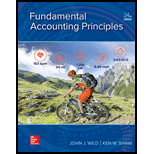
Sub Part-1
Interest Expenses paid in each interest period:
The Interest expense paid during each interest period is computed by multiplying the stated rate of interest on the nominal
The Interest expenses paid by the company on each interest period.
Sub Part 2.
Bonds Issuance:
The Bonds issuance by the company is a source of long term financing and is issued at a par value when the prevailing market rate of interest and stated rate of interest on bonds is equal. In such scenario, the investors are getting the same
Accounting treatment of interest payment:
The Accounting entry required to be passed at each interest period is debiting the total interest expense and credit being made to the cash account for cash interest paid.
The
The Journal entries for two interest payments.
Sub Part-3
Bonds Issuance:
The Bonds issuance by the company is a source of long term financing and is issued at a par value when the prevailing market rate of interest and stated rate of interest on bonds is equal. In such scenario, the investors are getting the same returns when the investing in bonds as they are getting from the investment made in market.
The Bonds issuance by the company is a source of long term financing and is issued at a discount or premium depending the prevailing market rate of interest and stated rate of interest on bonds. When the stated rate of interest is lower than the market rate of interest, then the investors will be ready to invest only in the situation when the bonds are issued at discount.
The Bonds issuance by the company is a source of long term financing and is issued at a discount or premium depending the prevailing market rate of interest and stated rate of interest on bonds. When the stated rate of interest is higher than the market rate of interest, then the investors will be ready to invest only in the situation when the bonds are issued at premium.
The Journal entry for the issuance of bonds at 98.
Sub Part-4
The Journal entry for the issuance of bonds at 102.
Want to see the full answer?
Check out a sample textbook solution
Chapter 14 Solutions
FUND.ACCT.PRIN.(LOOSELEAF)-W/ACCESS
- 1. Armor Company had the following information for the month of December. All direct materials were one hundred percent complete, and beginning materials cost $22,700. Work in Process Inventory Beginning balance @ 12/1: 420 units, 10% completed $ 26,000 Completed 1,050 units and transferred them to finished goods inventory $ 217,291 Direct materials 74,000 Direct labor 50,000 Overhead Property taxes 16,000 Depreciation 47,000 Utilities 31,000 Indirect labor 14,000 Ending balance @ 12/31: 405 units, 20% completed $ 40,709 Cost per equivalent unit for conversion under the FIFO method is calculated to be (rounded): 2. Shyne Incorporated calculates cost for an equivalent unit of production using the weighted-average method. Data for July: Work-in-process inventory, July 1 (38,000 units): Direct materials (96% completed) $ 122,600 Conversion (54% completed) 77,050 Balance in work in process inventory, July 1 $ 199,650 Units…arrow_forwardWhat is the profit marginarrow_forwardPlease answer the questions and accountingarrow_forward

 AccountingAccountingISBN:9781337272094Author:WARREN, Carl S., Reeve, James M., Duchac, Jonathan E.Publisher:Cengage Learning,
AccountingAccountingISBN:9781337272094Author:WARREN, Carl S., Reeve, James M., Duchac, Jonathan E.Publisher:Cengage Learning, Accounting Information SystemsAccountingISBN:9781337619202Author:Hall, James A.Publisher:Cengage Learning,
Accounting Information SystemsAccountingISBN:9781337619202Author:Hall, James A.Publisher:Cengage Learning, Horngren's Cost Accounting: A Managerial Emphasis...AccountingISBN:9780134475585Author:Srikant M. Datar, Madhav V. RajanPublisher:PEARSON
Horngren's Cost Accounting: A Managerial Emphasis...AccountingISBN:9780134475585Author:Srikant M. Datar, Madhav V. RajanPublisher:PEARSON Intermediate AccountingAccountingISBN:9781259722660Author:J. David Spiceland, Mark W. Nelson, Wayne M ThomasPublisher:McGraw-Hill Education
Intermediate AccountingAccountingISBN:9781259722660Author:J. David Spiceland, Mark W. Nelson, Wayne M ThomasPublisher:McGraw-Hill Education Financial and Managerial AccountingAccountingISBN:9781259726705Author:John J Wild, Ken W. Shaw, Barbara Chiappetta Fundamental Accounting PrinciplesPublisher:McGraw-Hill Education
Financial and Managerial AccountingAccountingISBN:9781259726705Author:John J Wild, Ken W. Shaw, Barbara Chiappetta Fundamental Accounting PrinciplesPublisher:McGraw-Hill Education





